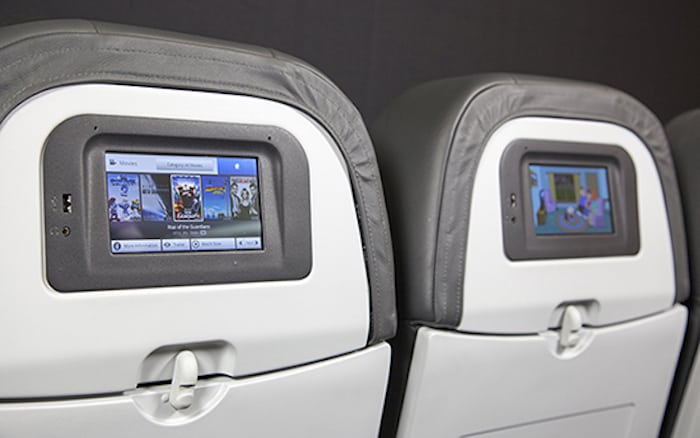Skift Take
"PAX" is not Latin for peace--it's aviation-speak for passenger. But the right IFE product could bring peace to the PAX cabin, psychologists say.
The latest development in in-flight entertainment (IFE)—a sleek product named iPAX—wants to make it impossible for airlines to ignore the large number of passengers sitting on their planes staring at some-shade-of-blue covers on the seat in front of them.
The new iPAX by Lumexis is a modern wIFE (wireless IFE) system which offers passengers a selection of high-definition entertainment on thin, light-weight seat-back screens. As a plus for passengers, wIFE systems don’t need those under-seat boxes which gobble-up precious legroom.
Besides entertainment content, airlines can display moving maps, add food and beverage menus, and play amusing safety videos on the iPAX system (as long as they’re Air New Zealand or a Virgin brand).
Lumexis’ product pitch is meant to tempt cost-conscious airlines by using words like “ultra-low cost” and “light-weight,” two sure-fire winners. But iPAX’s creators back up their marketing-speak with impressive numbers. The ultra-low price is $1,495 a pop and the ultra-light weight is 8.9 ounces.
If you’re wondering why $1,495 for something smaller than a tablet is a good deal, we should explain that aircraft interiors products are pricey: very pricey compared to consumer products. Aviation certification requirements make research, development, and production expensive. As aircraft interiors products go, this price is a bargain.
The iPAX’s screens project 1080 pixel video and options include a 2.1A USB charging port and a credit card reader to encourage that in-flight shopping. Lumexis CEO, Doug Cline, suggests airlines could earn “significant new ancillary revenue from offering a diversity of products and services.”
Lou Sharkey, President and COO of Lumexis, points out that the iPAX “costs less than a conventional overhead monitor system and weighs half as much, so the revenue it generates drops directly to the bottom line.”
There are plenty of airlines for Lumexis to target. “Some three-fourths of single-aisle aircraft fly on short-to-medium haul routes that could never before benefit from embedded IFE,” Cline says.
That’s a lot of passengers staring at the embroidered seat belt instructions, tempted to pull on that one lose thread which unravels the lot. These are hidden costs for airlines without IFE systems—spare seat covers are not cheap.
But will airlines buy into the pitch?
Most carriers have employed a strategy based on the discipline of high-revenue cabin footprint. To the layman, that means squeezing profits out of every inch of cabin space. Airlines have increased this footprint revenue by adding seats, but regulations limit how many seats airlines can put on planes. To airlines, this means getting creative and taking advantage of other revenue-generating opportunities like adding inexpensive, cost-reducing, ancillary-revenue-generating IFE systems.
Lumexis is not making this argument alone. IFE suppliers from around the world want to make it impossible for airlines to bore us in-flight. The battle of the seat back has led to development of a wide assortment of products, many of them tempting to airlines who would never have considered IFE before.
Organizers of the Aircraft Interiors Expo have announced that this year’s IFE zone will be 25% larger than last year’s—reflecting the importance of these systems for today’s cabin design. Zero-footprint cabin products will continue to grow and industry experts say wIFE solutions, like iPAX, will become an essential element of the modern IFE product mix.
The Daily Newsletter
Our daily coverage of the global travel industry. Written by editors and analysts from across Skift’s brands.
Have a confidential tip for Skift? Get in touch
Tags: amenities, in-flight, in-flight entertainment
Photo credit: The iPAX system in a seat. Lumexis
